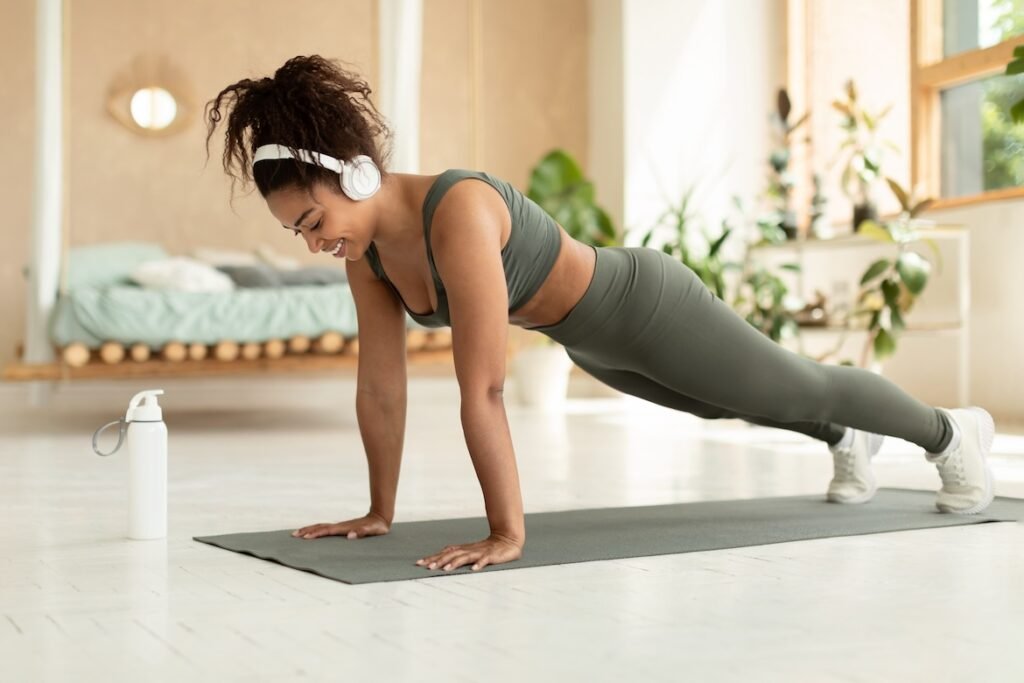When was the last time you did strength training? If you’re not good at lifting weights, you might be thinking, “Uh… never?” Or you might be wondering if there’s anything like it Yoga, Taekwondoor other bodyweight exercises can “count” as strength training.
The truth is, you don’t need to put your fingers on dumbbells or barbells to reap the benefits. “To get stronger, we just need to recruit and fatigue our muscle fibers,” explains Certified Exercise Physiologist Luke Carlson, CEP, CEO and Founder discover strength.
This can be done using machines, free weights, resistance bands or just body weight, he says. that’s right: Just your weight.
Don’t believe it? Read on as experts explain why bodyweight exercises can help you build strength and how to make sure they check the resistance training box.
Are bodyweight exercises considered strength training?
The answer is resounding Yes. “Bodyweight exercises are definitely strength training,” says certified personal trainer Nicole Thompson, CPT.
Rather than using equipment to provide external resistance to the muscles, these exercises utilize the body’s weight. “Exercises such as push-ups, pull-ups, and squats are typical examples. self-weight exercises Effectively trains a variety of muscle groups,” says Thompson. “Just like traditional weightlifting, bodyweight exercises can stimulate muscle growth, increase muscular endurance, and improve overall health.”
Although heavy weights can help you get stronger and build muscle, they are not necessary. take this Study in 20231 Posted in experimental physiologyFor example: Two groups of healthy adults were assigned to perform bodyweight or free-weight resistance training for eight weeks, and researchers found that both groups experienced significant increases in muscle size.
other small research2 Published in August 2023 scientific report A study of young women compared six weeks of progressive bodyweight squat training to six weeks of barbell squat training and found similar gains in muscle strength and size in both groups.
“Research has concluded that the weight we lift is not really the key to improving strength,” Carlson explains. “The key is to get to or very close to the point of transient muscle failure.” Transient muscle failure is when your muscles are too tired to do any more reps.
researcher It is hypothesized that muscle fatigue to this degree will result in maximal muscle fiber activation, helping to maximize muscle adaptation. Muscle fatigue appears to be more important when training with lighter loads, such as bodyweight training.
For someone who is already well trained, these types of exercises may seem like it is too easy to reach muscle fatigue, but this is a common misconception. There are many ways to improve your bodyweight movements so you can effectively challenge yourself. For intermediate to advanced athletes, air squats may be easy, but think about how difficult it would be to do pull-ups, push-ups, box jumps, or box jumps. pistol squat For representatives.
“To make exercise more difficult or to hit a plateau, you can use the FITT principles: frequency, intensity, time and type,” says Thompson. For example, you can manipulate these factors in a variety of ways during bodyweight training:
- Increase reps or sets
- Increase the intensity of the movement (i.e. add jumps to squats or claps to push-ups)
- Adjust leverage points (i.e. elevate your feet during push-ups or move from forearm plank to high plank)
- Combine unilateral exercises (using one side of the body at a time)
- Increase stressful timelike adding an isometric hold (for example, holding a pull-up in the top position or holding a plank longer)
- Reduce rest periods to increase exercise density and intensity
If you feel like exercising is too easy, you’re never sore, or your results plateau despite consistent exercise, it might be time to change up your exercise routine, says Thompson. You may need to use some of the variables above to continually increase the demand on your muscles, or bodyweight exercises may no longer be enough for you.
body weight exercise No doubt it can can help you build strength, but they do have limitations. If you no longer feel challenged without external resistance and you’ve tried various techniques to improve your movement, it might be time to pick up some bands or weights.
“Bodyweight exercises can stimulate muscle growth, increase muscular endurance, and improve overall health.” —Nicole Thompson, CPT
Other benefits of bodyweight exercise
In addition to helping you build strength and muscle, bodyweight exercises have several other benefits for your body and brain.
First, bodyweight exercises are usually functional fitness All-star. “Many bodyweight exercises mimic activities of daily living and improve ease of performing daily tasks,” says Thompson. She adds that they promote a stronger mind-body connection and increase body awareness, balance, coordination and control, thereby improving overall athletic ability.
Many bodyweight movements are compound exercises (It works multiple muscle groups) and also engages the core, which can have a host of positive effects, such as improving posture, balance and stability, Thompson says.
Bodyweight exercises can also double as cardio, especially when you add plyometrics, increase rep speed, and reduce rest periods. For example, a April 2021 Small Research4 Posted in international journal of exercise science Research has found that just 11 minutes of bodyweight training (six exercises with active recovery in between) can significantly improve the cardiorespiratory fitness of inactive adults.
If you’ve ever done a bodyweight HIIT workout, you know there’s no limit to intensity; another study5published in July 2021 The forefront of sport and active livingfound that 4 weeks of bodyweight HIIT improved cardiorespiratory fitness in healthy young adults.
In addition to their physiological effects, bodyweight exercises are convenient, accessible, and cost-effective. “They can be done virtually anywhere and without the need for exercise equipment, making it easier to maintain consistency,” Thompson says.
Ultimately, Thompson says bodyweight exercises are very versatile and can be modified for any fitness level. When you bring pull-up bars, steps, benches, etc., exercise slideror a suspension trainer (such as a TRX) to help you use your weight in new ways, the options are nearly endless.
bottom line
Don’t neglect bodyweight exercises to build strength. As long as you push your muscles to their limits when training, you’ll gain something.
“Research clearly shows that regardless of the goal, the approach to strength training is very similar,” Carlson said. “A few years ago, we assumed that the weight we used, the number of reps we performed, or the type of equipment we used would significantly affect our results.” Now, we know that what matters most is your effort.
To effectively incorporate bodyweight strength exercises into your workout routine, Thompson says it’s best to create a balanced plan that includes exercises that target all major muscle groups: upper body, lower body, and core. Aim to train at least two to three times a week and allow for rest days for recovery.
Just because bodyweight exercises are effective for building strength, it doesn’t mean weightlifting is evil or that you need to throw all other types of exercise in the trash. “Combining body weight exercise with aerobic exercise or flexibility training Comprehensive fitness plans can be developed. This approach helps prevent burnout and monotony, making your workouts fun and engaging,” adds Thompson.
If you find it difficult to put it into practice on your own, consider working with an exercise professional to design a plan that fits your goals and abilities. “They can help you stay consistent while building strength safely by providing accountability and guidance,” says Thompson. Stick with bodyweight exercises, and you might find yourself boosted unexpectedly—just don’t say we didn’t warn you.
Well+Good articles cite scientific, reliable, up-to-date, robust research to support the information we share. You can count on us on your health journey.
- Okawa M, Hashimoto Y, Mochizuki Y, Inoguchi T, Kouzuma A, Deguchi M, Saito M, Homma H, Kikuchi N, Okamoto T. in healthy young and middle-aged people. Experimental Physiology. 2023 Jul;108(7):975-985. doi:10.1113/EP090655. Epub May 3, 2023. PMCID: PMC10988481.
- Wei, W., Zhu, J., Ren, S. et al. Effects of progressive bodyweight versus barbell back squat training on strength, hypertrophy, and body fat in sedentary young women. scientific representative 1313505 (2023). https://doi.org/10.1038/s41598-023-40319-x
- Nóbrega SR, Liberdi CA. Is resistance training necessary for muscle failure? Pre-Physiology. January 29, 2016;7:10. doi:10.3389/fphys.2016.00010. Phone number: 26858654; PMCID: PMC4731492.
- Achila LR, Bostad W, Joyner MJ, Gibala MJ. Simple bodyweight training improves cardiorespiratory fitness with minimal time investment: Contemporary applications of the 5BX method. International Journal of Exercise Science. 2021 Apr 1;14(3):93-100. Phone number: 34055156; PMCID: PMC8136567.
- Sian TS, Inns T, Gates A, Doleman B, Gharahdaghi N, Atherton PJ, Lund JN, Phillips BE. Short-term, equipment-free high-intensity interval training can significantly improve cardiorespiratory fitness with or without supervision in early adulthood. Cutting edge sports law life. 2021 Jul 26;3:697518. DOI: 10.3389/fspor.2021.697518. Phone number: 34381998; PMCID: PMC8349982.

